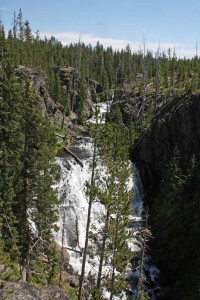Lone Star Geyser
Posted by Jim Steele on August 19th, 2008 filed in Yellowstone National ParkOne of the coolest short hikes in Yellowstone National Park is Lone Star Geyser – especially if you’re hoping for a chance to see a fairly large geyser erupt from up close. Lone Star erupts regularly every three hours to a height of around 40 feet. Running into a thermal feature in the Yellowstone backcountry is always an adventure, and Lone Star is no exception. You’ll probably be watching with just a dozen or so other people, and the lack of boardwalks and crowds means you’ll have a great view.
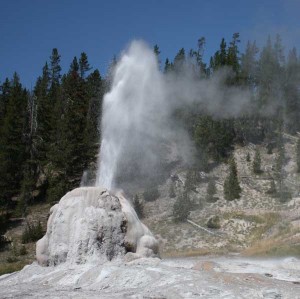
Even better, it’s an easy – and family friendly – hike. The trail is level the whole way, with nominal elevation gain. You’ll hover within a few dozen feet of 7,600 feet for the whole trip. The trail is an old road, so it’s easy to follow. And the distance – just 2.5 miles each way – makes it a good trip for hikers of most ages. This is one of the few Yellowstone trails that is friendly to mountain bikers. In the winter, Lone Star is open to cross-country skiers.
View Larger Map
The trailhead is easy to find. It’s 2.5 miles east of the Old Faithful interchange on the Grand Loop Road. As you travel east from Old Faithful, you’ll begin climbing out of the valley. As you climb, you’ll pass the parking area for the Kepler Cascades; the Lone Star Trailhead is just east of the Kepler Cascades area and is marked with a small sign along the highway.
The trail is relaxing and serene. You’ll follow the Firehole River virtually the entire way and the walk is particularly enjoyable if the vegetation is still green. You could be treated to wildflowers and wildlife along the way. You’ll spend most of the time walking through the forest, although you will see a few meadows that invite you to watch for elk.
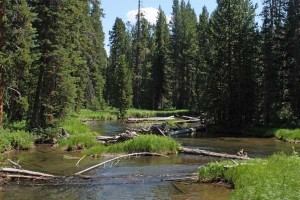
There is a small thermal feature just a couple of minutes off the trail. It’s not marked, although you’ll be able to see the trail that leads to it. About a third of the way to Lone Star, you’ll cross a bridge over the Firehole River. After you cross, the trail opens into a long straightaway. It jogs slightly then opens into a second straightaway. About halfway through the second straightaway you’ll see the trails leading to the small gurgling pool to the west of the main trail. Like most backcountry thermal areas, the trail isn’t marked, but you’re free to explore as long as you stay a safe distance away from the boiling waters.
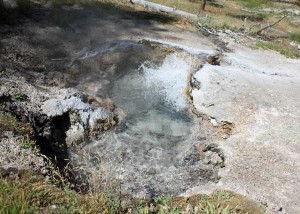
About two-thirds of the way to Lone Star Geyser, you’ll come to a marked junction with the Spring Creek trail, which leads to the Divide Lookout Trail in 4.2 miles. As you come closer to Lone Star, the Firehole will pull away from the trail, framing a serene meadow to the east. However, you’re never far from the Firehole on this trail and it eventually meanders to within a few dozen yards of Lone Star Geyser.
Just before Lone Star, a small barrier will mark the end of the road for bicyclists; you have to walk the rest of the way. You’ll see Lone Star’s nine-foot tall cone in the distance. The geyser was named due to its relative isolation from the rest of the Old Faithful area’s thermal features.
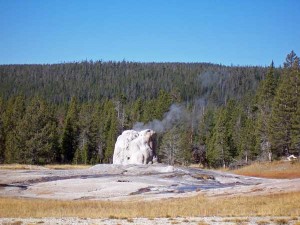
Now you just have to hope that you timed your trip right so that you won’t have to wait long for an eruption. Lone Star erupts every three hours and the Old Faithful Visitor Center attempts to track its eruptions, so with a little help, you might be able to plan your trip perfectly. Visitors keep an eruption log at the geyser so that you have an idea of how long you’ll have to wait. The geyser will begin a splashing phase 60 to 90 minutes after the main eruption. Next you’ll see at least one minor eruption, which can reach approximately 40 feet but only lasts for a few minutes. Don’t confuse the minor eruption with the main eruption, which lasts for 20 to 30 minutes and will probably start about a half hour after the minor eruption. There can be more than one minor eruption. If you’re lucky, the mist coming off Lone Star will make a rainbow. And don’t be surprised if the geyser’s spray starts to land on you. Afterwards, a noisy steam phase will let you know that the show is over.
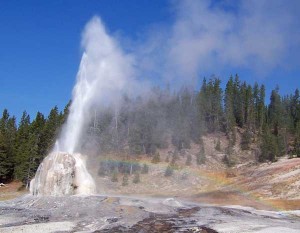
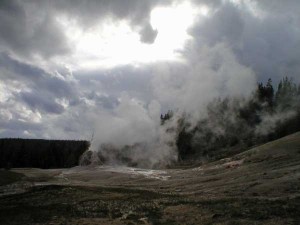
If you get to Lone Star and have some time before the next eruption, explore the area. The junction with the Howard Eaton Trail, which starts near the Old Faithful area, and the trail that leads to Shoshone Lake and the Shoshone Geyser Basin is just a few minutes past Lone Star. Around that area, there are a few more small thermal features, as well as a backcountry campsite. You’re not going to discover the next Old Faithful, but it’s an interesting area to explore.
If you want to make a much longer backcountry adventure, continue on for six miles to the Shoshone Geyser Basin and Shoshone Lake. The junction with this trail is just a few minutes past Lone Star Geyser. You’ll pass a few small thermal features, climb the modest Grants Pass and the Continental Divide, descend to a junction with a trail that leads to the Bechler area, and then continue on for two more miles to the lake and geyser basin. Shoshone Lake is gorgeous – and not accessible by road – and the Shoshone Geyser Basin is a fascinating area. It’s one of the largest backcountry geyser basins in Yellowstone and you’ll see a great variety of thermal features. There are more backcountry campsites near Shoshone Lake, so you have the option of making this a great overnighter. Also, the relatively low elevation of this trail makes it accessible later in the season – I hiked it in early November 2007, encountering nothing worse than a few inches of snow on Grants Pass.
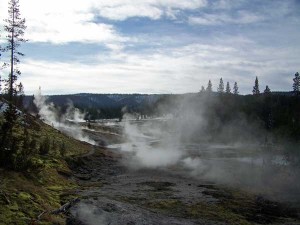
Once you get back to the trailhead, where cell service is available, call the Old Faithful Visitor Center at (307) 545.2750 to report the time of the eruption. And don’t forget to wander down to the Kepler Cascades. It’s intriguing to watch the contrast of the serene Firehole River along the Lone Star Geyser trail with the gorgeous cascades.
